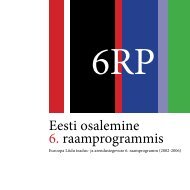Reactive Systems: Modelling, Specification and Verification - Cs.ioc.ee
Reactive Systems: Modelling, Specification and Verification - Cs.ioc.ee
Reactive Systems: Modelling, Specification and Verification - Cs.ioc.ee
You also want an ePaper? Increase the reach of your titles
YUMPU automatically turns print PDFs into web optimized ePapers that Google loves.
10 CHAPTER 2. THE LANGUAGE CCS<br />
✬<br />
✫✉<br />
✩<br />
coff<strong>ee</strong> ✉ ✉ CS pub<br />
coin<br />
✪<br />
Figure 2.1: The interface for process CS<br />
all is the process 0 (read ‘nil’). This is the most boring process imaginable, as it<br />
performs no action whatsoever. The process 0 offers the prototypical example of a<br />
deadlocked behaviour—one that cannot proc<strong>ee</strong>d any further in its computation.<br />
The most basic process constructor in CCS is action prefixing. Two example<br />
processes built using 0 <strong>and</strong> action prefixing are a match <strong>and</strong> a complex match,<br />
described by the expressions<br />
strike.0 <strong>and</strong> take.strike.0 ,<br />
respectively. Intuitively, a match is a process that dies when stricken (i.e., that<br />
becomes the process 0 after executing the action strike), <strong>and</strong> a complex match is<br />
one that n<strong>ee</strong>ds to be taken before it can behave like a match. More in general, the<br />
formation rule for action prefixing says that:<br />
If P is a process <strong>and</strong> a is a label, then a.P is a process.<br />
The idea is that a label, like strike or pub, will denote an input or output action on<br />
a communication port, <strong>and</strong> that the process a.P is one that begins by performing<br />
action a <strong>and</strong> behaves like P thereafter.<br />
We have already mentioned that processes can be given names, very much like<br />
procedures can. This means that we can introduce names for (complex) processes,<br />
<strong>and</strong> that we can use these names in defining other process descriptions. For instance,<br />
we can give the name Match to the complex match thus:<br />
Match def<br />
= take.strike.0 .<br />
The introduction of names for processes allows us to give recursive definitions of<br />
process behaviours—compare with the recursive definition of procedures or methods<br />
in your favourite programming language. For instance, we may define the
















